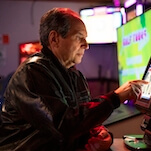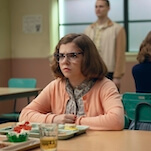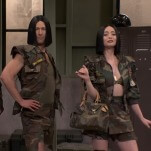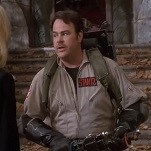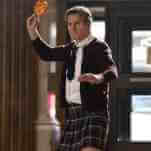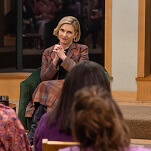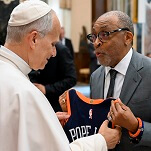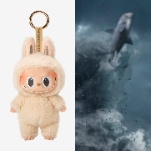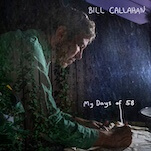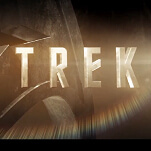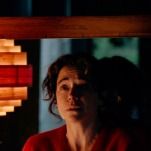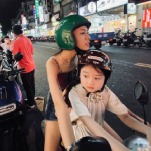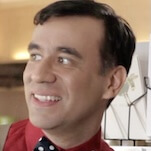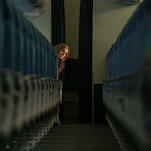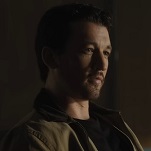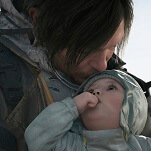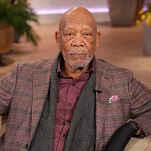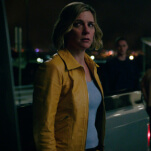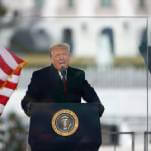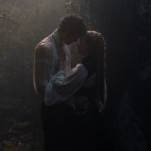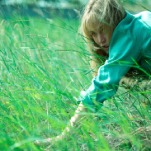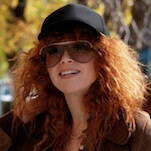How does Chicago Fire keep its fake fires from going full O’Leary?

In Expert Witness, The A.V. Club talks to industry insiders about the actual business of entertainment in hopes of shedding some light on how the pop-culture sausage gets made.
A raging fire is a dangerous proposition, even in the most controlled situations. Although the effects team on Chicago Fire takes every precaution to avoid flare-ups on its fiery sets, the show still faces down certain disaster almost every episode, as its firefighting heroes battle everything from drums of exploding gas to cars precariously dangling from parking garages. How does the show make sure its actors, crew, and locations remain safe while maintaining realism on screen? The A.V. Club talked fireballs, smoke, and safety with Chicago Fire’s special effects coordinator, John Milinac, and one of its technical advisors, former firefighter Steve “Chik” Chikerotis, ahead of the show’s season finale this evening.
The A.V. Club: First, how do your jobs on the show differ? What are you each responsible for?
John Milinac: My responsibility is to interpret and understand what the directors and the writers want to do, which is information that Chik provides them on storylines, and to figure out any special effect—whether it’s fire or mechanical—that we can supply, realize, and operate on camera. We may find ourselves working in conjunction with visual effects, but the show is primarily a mechanical effects show. We’re the department that generates stuff that needs to be shot on camera at location or on the stage.
Steve Chikerotis: John gives us that big-screen look, because he and his team are the best I’ve ever worked with in 25 years in the business, and I’ve worked with Academy Award winners. I work with a great team of creative people and writers. Sometimes I’ll generate an idea or I will fine-tune an idea as far as action screens, trying to keep things accurate.
AVC: Chik, you talked about working with the writers, coming up with ideas. What’s that process like? Do they just say, “We want to shoot something in a skyscraper. What should we do?”
SC: Sometimes it’s as vague as that. Sometimes it’s just, “We want a scene, Herrmann’s in jeopardy, and Casey is the hero.” And sometimes they’re more specific: They know they want it to be a fire or a car crash in a particular place, and then I can help them out from that point. Sometimes I generate them.
June 1, the writers’ room opens up, and the first week is just pitching storyline ideas and trying to fill up a board for the season of general ideas that the writers and team will take and break down into individual episodes.
AVC: You’re coming at this from experience?
SC: Yeah, I only recently retired. I was a firefighter for 36 years and retired as a deputy district chief, but I’ve also been a writer for about 22 years and working in the industry for about 25 years. So I’ve got a blend of all that stuff.
AVC: Do you have a sense of how the show tries to balance action and drama?
SC: Sometimes the action drives the plot and storylines, and sometimes the drama drives the storylines, and the action is literally that. They’ll go and mitigate some sort of incident that John will help us create visually with his great team, and sometimes it is the storyline. Sometimes the action is a character in itself.
AVC: How does the writing team and the effects team work hand in hand? When something is written into the script, like a car crash, how specifically is it written?
SC: It’s written pretty specifically.
I will probably know sometimes two months ahead of time—sometimes a week ahead of time, depending on where we are in the season—what’s going to pop up at the next concept meeting for an episode. I try and tip off John so he can be somewhat prepared, but you really can’t. John sits at our concept meeting down the table from me, next to our stunt coordinator, Rick Le Fevour, who also plays really big in making everything happen. And I keep a couple people between us, because I know they’re going to break my pencil when they read some of the things that they have to do.
John has a journal with him, and we’ll come up with something—like a car crashes through a barrier of the roof of a six-story parking garage, and it teeters with its victim in peril in the front seat, and [Kelly] Severide has to come off the roof, break the back window, enter the back roof, and pull the victim out just as the car tumbles down six stories. And I’ll look down at the end of the table, and John doesn’t even flinch. He’s sketching things. By the end of the meeting, he’ll have a sketch of the way he’ll make it work. It boggles my mind. It’s amazing.
AVC: John, how much time do you usually get from page to shoot day?
JM: Chik is absolutely correct that once the concept meeting occurs, that’s when everything is becoming a little more reality-based, instead of from the outline that I might read two weeks in advance. The details from that are only really hinting at where things are going. But once the concept meeting starts, we’re eight days out from shooting. At very best, if it’s going to be a complex event or series of events, it would probably get pushed to the back end of the schedule. That would give me 16 days in all to generate and conceptualize and even test to make sure it’s safe and predictable. But there are other stopgaps in between.
We really can’t go further until we have a location. And we can’t go further with the location until we understand the action. There are several layers to get to the point where you say, “Okay, now we can turn wrenches.” We may have a concept in the shop that I’ll have everybody come down and look at. We don’t have a lot of time because of television timing to do things twice, so we try to say, “This is a rough mechanical build. Would this work? Are we headed the right way?” The director may not have visualized it the way I do, so we have to be very clear when we’re producing this stuff that it’s what everybody thought it was going to do—and it’s shootable, safe, the actors can interact with it—and install it in a couple of days, because we’ll have had to test it in the shop.
Once the location is prepared, we’ll say, “Okay, we’ll go in there now.” Two days later, we shoot it, tear it down, get into the next event. So they start overlapping. It’s a conveyor belt of ideas.
Like most productions, there’s sidestepping that occurs. We’ll say, “Well, we’re not going to get the location we thought,” so that might change your rig. We’re not going to have the time we thought, because actor availability might change from the time you thought they were available. It’s a very liquid and dynamic situation. It ebbs and flows.
AVC: Chik mentioned the car hanging off the roof. Do you have a bunch of cars just sitting around? Do you have to send an intern out to buy a junker?
JM: Our transportation department has a branch of picture cars. Whether it’s a car crash, major or minor, a series of cars, or one car coming off of a building, that car has to be approved by the director and the art department. It may be the wrong color, so it may have to get painted, and they’ll want the engine and transmission removed to make it so there’s less hazardous waste in the car so we don’t make a mess, and be production-friendly to our neighbors in our locations. For any of those scenarios we’re talking about, we may have the car for a day or for a couple of hours, but a gig like that one, we would probably have the car for several days.
The gig to which Chik is referring, we actually had to make an angular sled ski slope on the top of the parking garage so the car could be loaded on with a crane, set trips, safety cables, and all that, because the actors are actually going to climb around this stuff with the stunt team. When we say we’ve got all that, then we’re going to release the car, and you’re basically cutting a cable and letting gravity go to work for you.
So all that stuff has to be thought through. What’s going to happen next? You better put a trench plate in the street so we don’t damage the street. Paint it to look like asphalt, because the art department will come back in and say, “That trench plate doesn’t look like asphalt.” So there are layers that keep turning and new dominoes to make sure all the departments are reacting in the same direction and not being surprised by it.
AVC: You can probably only do things so many times. You only get one or two takes to drop a car off a roof. You’ve got to do it right.
JM: Yeah, that’s very accurate. There are some gags that are actually a one-time deal. Sometimes it’s a stunt, crashing a car. On a feature, you might say, “Go get me another spare Lincoln that’s ready to go. We might have to do this twice.” Not so much on a television show with a timeline, where you have to have enough cameras to get enough coverage. We’re going to get this once, and we’re going to move on.
There are many gags where that’s the case, and there are just as many where it is repeatable. The door needs to come off in such a way that you put the door back on. We have it so the actors can sell the idea. There are tools to help get a door off a car. We make it so it can be done repeatedly, put it back on, like a cabinet door.
If we’re doing fire events, we have to make it so we can set levels on fires, and everybody approves—the actors, the stunts—and says, “That’s a repeatable thing to do over and over again.” That’s part of why we remain safe, because of testing and everybody understanding where they’re going to be, when they need to be there, and how big something’s going to be or how small we make something so everybody understands which is an actor’s version and which is the stunt version.
AVC: How real do you try to make what happens on screen compared to real life?
JM: Craig Jackson, our production designer, pushes very hard to keep things looking real, looking accurate. All the materials we’re using, there’s no cutting back as far as, “Well, that didn’t look like the proper wood grain,” or whatever. In general terms, we’re doing everything as real as possible as far as safety and time can allow us to do.
For us, it’s real daily. I’ll let Chik decide if it looks real or not.
SC: It certainly does. In fact, it’s art imitating life. It’s not just imitating life, it’s imitating one of the most dangerous jobs on Earth, so just that alone makes it dangerous for the actors and the production team. Everything is geared safe, but we also want it as authentic as possible.
The only exception—and this is what firefighters will call me on all the time, but they get it—is that the smoke is 90 percent less than in an actual incident. If you shut your eyes right now, that’s our visibility in an average fire. It wouldn’t be a television show; it’d be a radio show. So we have to lighten up the smoke.
Everything else is very accurate. Sometimes we tone things down from real events that have happened, because real life would not be believable to people.
AVC: What kind of safety regulations, laws, or guidelines are in place on the set to keep people safe?
SC: The good thing is that we have redundancy. We don’t just have one person that’s concerned with safety. We have a nice team that’s been in place now for four seasons. There are no cowboys just rushing to do things. Every department from our grips to our stunts, and certainly special effects, everybody gets the safety aspect. And we stress it. We’re watching out for each other, because we’re like a family.
JM: Because of the show that we are, everybody’s going to want everything to look as real as possible, as large-scale as possible, as cinematic as possible. When we’re doing these things, there are several factors.
Studio safety is involved, and there are safety meetings throughout the day about what we’re going to do. We’re reminding ourselves that this is actually an industrial job in an entertainment industry, and people can be injured even if we’re not doing fire. We can be doing something minor, and you could still have something that you need to be aware of daily.
Most people will say you have to be aware of the fires. The fire days are probably the days we are 100 percent aware of what can happen. It’s the days when there’s not a fire that we can’t let our guard down, because it didn’t seem like it’d be a threatening day for someone to trip, someone to bump into something, a sharp edge that wasn’t addressed earlier, or even actors taking a miscue and landing in the wrong place. So it’s a constant awareness on all days, not just on a fire event.
SC: For the actors, for the cast, every day is like a training day. If they’re going to be climbing ladders that day, swinging axes, smashing in a door, using hydraulic tools or the Jaws Of Life, all of those acts can be dangerous unless you’re trained properly. We’ve had several training sessions, and they will be never-ending. If we go 10 seasons, we’ll still be training. When it comes time to climb an aerial ladder, we’ll revisit the safety aspects again.
AVC: How do you use your burn stage?
JM: Of all the spaces that we utilize here at the studio, many of them are the typical interior stage sets that have been built for day-to-day shooting. There’s one stage that is unique, in that it’s where we’re going to do all our fire events.
There are three different set elements in there. One is up on the mezzanine that can be used as a two-story set. Another one is more of an apartment long-hallway set, which is constantly being converted by the art department to whatever the script needs. Every episode might need less of a hallway and more of a bedroom, and now we need more of a bedroom and less of a closet, so it’s always being reconfigured with material that the Chicago Fire Department and we understand.
When we bring fires into that environment, with our propane fire bars in various places, everybody in there understands that the fire is controlled and nothing else can burn in that space, except for what we have decided can burn. So when we say “fire out,” and turn off our propane valves, the fire literally does go out. There’s really nothing left burning unless there’s a piece of paper or smoldering wood or something, which then fire safety is standing by, and they’ll just squirt some water on it to stay ahead of it. They are watching for things in a wider perimeter than we are. We’re watching the actors, we’re watching the camera, we’re watching what we’re doing—they’re watching us. Everybody is watching each other’s back. If somebody says “I’m not clear” or “I don’t understand” or “That didn’t feel right,” we stop, we revisit, we start over and make sure everybody’s on the same page.
That stage allows us—depending on the configuration or the storyline—to allow pretty large-scale fires and propane mortars, fireballs, collapsed ceilings. Whatever the particular episode requires, that’s the safest place to do it. At least versus doing it in one of the general stages, where we have a lot of smoke to be dealt with or the aftermath of some smells, some fuels, and some materials that singe. With this stage, ventilators are on for 10 minutes and the air’s clean.
SC: The way that we make things happen, it fools even real firefighters regularly. I still teach thousands of firefighters every year in tactics and leadership. When I’m at class, they always want to talk about this show, and they’ll ask, “How did you drop that roof of that building?” or “Where do you burn these buildings?” And in actuality, no buildings are ever burning.
We’ll have locations. If they rent your house, they will pay you for renting it for a couple of days: a day for setup, a day for a takedown, and the actual day we film. And then John’s crew will come out and measure your windows and doors and replace them with our windows and doors. Instead of just a window, it will be an insulated firebox that they can run propane fires and hand-pumped smoke through, so that nothing is penetrating into the actual house. It’s just coming out of this firebox. We’ll crash in through doors that John will put up and our art department will put up and drag in dry hose lines so that we don’t accidentally flood your home. They’re charged with air.
To make things like roofs collapse, John will send up explosions rising up to the roof with black smoke and simultaneously, like, a split-second later, blow out windows at lower levels, which looks exactly like what we see in the real world when an entire roof gives way in a warehouse. For interiors, when you see the interior fire attack and rescue scenes, that’s all done on our burn stage.
Again, our great art department, headed up by Craig Jackson, can build absolutely anything to match what we have on location. And then you add in John’s handiwork and Rick Le Fevour’s stunt people, and it all comes into play and has a real look that fools firefighters.
AVC: When you blow out a window, you’re not really blowing out a real window, you’re blowing out a fire-boxed window?
JM: Well, it may depend on what’s happening. There are going to be certain cases where we’re going to have a balsa-wood window and breakaway glass or candied glass. So that may get blown out, and there may be stunt players in front of that. That may not have fire in it, for example. Or if it does, maybe it’s a fireball that quickly dissipates.
We’ll set that up basically in your living room. We’ll put protection down and make sure we don’t scuff your floors or walls. So when we do this event, it’s repeatable again, as we talked about. After that, we cut back. Now we’re inside on the burn stage, and that room’s on fire.
Other times, we might take our fireboxes, these sheet-metal boxes—think of them as oversized medicine cabinets that slide into your window opening—and we’ll use some high-performance glass elements that won’t break, or we make our own mini-blinds out of metal bandings, so there are textures in the window when that fire’s brought up to the level that the director wants. I can fire propane mortar through a connector in the back of that firebox, so now you have a firebox that has a fireball coming out of it. And I can do that over and over again. And everybody on the street level would do their reactions like something’s happened inside the building. Cut back to the interior—now there’s fire on the floor that we’ve dressed, and everybody knows where they’re going to stand.
Intercutting those two, from location to stage work, is the stitching that makes it seem like we’re in the same building.
AVC: How involved is the actual Chicago Fire Department? Are they on set for every shoot? How do you coordinate with them?
SC: We have a fire-safety team that’s headed by one of our firefighters. He’s been doing it for over 25 years. He will hire off-duty firefighters to work safety, and they’ll drive the apparatus to and from our locations. They’ll stretch hose lines in case something happens, if a firebox or something was to get away from us. We don’t just chance that everything is going to work perfectly. You always prepare for when it doesn’t.
Depending on the size of the event, some days we might have up to 10 fire-safety officers on the scene. A lot of our extra background firefighters are actual firefighters. So we always have a team in place if needed.
AVC: Is that support something that the show is paying the city of Chicago for?
SC: I’m sure they do, but that’s above my pay grade. It really doesn’t concern me how it works, but most of the payment would be for people working on their off days. So you may have a firefighter that’s on one of his off days, and he’s getting paid.
I don’t know what the deal is with the city and the network. That would be something that would be decided by lawyers and people like that.
AVC: Is your show more expensive to shoot than other hour-long dramas?
SC: It is, and that’s an advantage and a disadvantage.
It’s an advantage that there haven’t been a lot of fire shows, due to the fact that they’re cost-prohibitive. We can have an exciting police scene with a shoot-out, and you, John, and I could have guns with blanks, and John’s people would set up a couple of squib hits that would explode if one of us gets shot on a steel plate underneath your clothing. But compare that to taking over a whole building and fireboxes and explosions and everything needed with the fire show. That’s the disadvantage cost-wise, but the advantage is that there’s untapped stories. Police shows have a hard time finding new material. They’re recycling things that have been done for years and years and years. We haven’t even hit the tip of the iceberg. We have enough storylines that we’ll probably run out at about season 30.
AVC: Are there fireproof cameras? Is it all long range? Are there GoPros set up that can take fire blasts?
JM: It’s all the above. The grip department, working with the camera department, they’ll decide what are the best camera angles. We’ll give them input and say, “You might want to look here, because this is what’s going to happen, this is going to eject that way, that’s going to go up that way.” They’re also looking for skyline and cinematic—you know, we would like to get the city of Chicago in the background in most cases—so there will be those angles. But if they say, “John, how close can we be with a manned camera?” I might say, “Well, I wouldn’t put a manned camera any closer than this. If you had a manned camera, I would put it here. I would put a wind cover in front of him, just in case some loose piece of gravel or something goes flying.” So we try to build a perimeter for all the unmanned cameras. The GoPros are locked off closer to the set for visual impact, and then there are manned operator cameras and so on as the perimeter gets wider.
As far as fireproofing cameras, the grip department will wrap those cameras in fire cloth to abate any heat. But in most cases, we try to make it so the camera isn’t actually in the fire anyway. If the camera operator is walking down the hallway on the burn stage, I’ll start turning off fires behind him. There’s actually three or four people behind him in general. So we fire up as we do, we set our levels, they roll cameras, they get slates, and smoke levels are checked so we don’t have to slow down or double back. There’s a very strong set of procedures, so when we say fire up, we’re moving forward, they’ll do the action, and we’ll have a reasonable amount of time that they’ll film a fire bit or that part of the scene. And as the camera or actors are moving around, and that becomes an off-camera fire, I’ll turn them off.
The set can get very hot. We have to ventilate the set in certain ways. We’ll open up panels. Craig Jackson will design different ceiling pieces that can be removed. Think of a chimney. We’ve got to let heat out of the set so we can tolerate being in there. All of the actors are wearing legitimate turnout gear and are on bottled air, and the shooting crew is wearing fireproof gear. But our victims—we’ll fire-retard their clothes, but we can’t let them sustain so much heat that we can’t do the scene. So that’s where we’ll modify the fire. Rick will approve it, saying, “That’s a better level for here, that can be stronger over there. This is the stunt double, he’s wearing stunt gel.” That’s another cooling agent that we can put on him so the fire can be a little bit stronger.
It has to be evaluated constantly: What we’re doing and what the impact is either to the camera or the crew or the actors.
AVC: You said a reasonable amount of time. Do you have a rule for that, or is it just, “It’s getting too hot in here?”
JM: Well, there’s always that. One of the rules that we all understand is that anybody can yell “fire out.” If anybody feels that it’s gotten too hot where they were or if anyone sees something that seems unnatural, we’ll turn off all the valves and re-evaluate what’s happening.
AVC: Are you doing that manually? Or are you working with computers?
JM: This is a manual system. Without getting into too many nuts and bolts, we have our propane tanks that we keep outside the stage. We’ll run feeder hoses into the stage, and we’ll have a series of manifolds with different valves on them. Each valve is numbered, and each person operating each manifold knows which fire pipes he’s running in a hallway or a bedroom or wherever on the schematic that’s been generated by the art department. We will set levels on every one of those pipes so we can understand which are the high levels and which are the low levels. We’ll look at it with everything on so that the actors have seen it and aren’t surprised. So when we understand what’s going on in there, you already have confidence to say, “This is the fire we expected it to be.”
If it’s too hot, we can feel out how long a take’s going to be. Thirty seconds is a little long. Ninety seconds is too long. So most of the takes are shorter, unless I say we can go through and start canceling fires. To prolong the take, we’ll turn off certain fires that you wouldn’t see.
AVC: You try to be a practical effects show rather than a visual effects show. How do you use visual effects?
SC: Pretty sparingly. We’ll use visual effects sometimes to enhance fire or smoke in areas where maybe a child has to be, so that we’re not really putting a child near anything that could be dangerous to them. We might use visual effects to wipe out a protective cable that’s holding a stuntman in place so he doesn’t fall off of a building. But other than that, with John, most of the show is his canvas.
JM: I’ve talked to visual effects, and they’ve said, “John, if it wasn’t for the fact that Chicago’s a windy city, we wouldn’t have anything to do.” Because if it’s windy, the firebox doesn’t react any way you want it to. So if we’re having an issue where I can’t quite get the fire to cooperate because of weather, visual effects will augment, just to help tie it in so it doesn’t look like a firebox is empty, for example. They’ll add some of their resource and say, “We augmented because that was failing a bit.” They’ll just add a little smoke here and there, but most of the time it’s us.
AVC: Do people want fires to look a certain way? Do viewers always want bigger and bolder?
JM: On the crew department shirt and hat that I had made for our guys, the back says, “More smoke, more fire.” Because one of the earlier producers, no matter what I put out there, he wanted more of it. So it became the mantra that, even if we’re just setting levels for the room, he’d say, “Can it be a little bit bigger?”
There’s always the pushing of how much bigger can it be, safely, and we push back. We’ll say, “That’s as big as it can get,” and they’ll say, “No problem, that’s plenty.”
SC: Mostly, in the real world, what you’re dealing with is burning synthetics, which are nasty—they’re carcinogens, they’re black, they’re hot. When a firefighter arrives to a fire at a building, as they enter, the ceiling temperature is already 1,300 degrees. And probably by the time we arrive, even if you get there in a couple of minutes, it’s zero visibility all the way to the floor level. And we’re working against a ticking clock, because if the whole room flashes over where it comes down to floor level, a firefighter, even in all his protective gear, can only survive 11 seconds. So if you’re deep into a place and don’t know the layout of the building due to the zero visibility and it flashes over, you’re going to have a hard time getting out. Even more importantly, a civilian, the people that we’re sworn to protect, they can survive 300 degrees for one minute.
So it’s a whole different world than we’re dealing with on the set. We’re working in a dangerous environment, but nowhere near the levels that an actual fire is. And that’s John’s artwork. The ceiling temperature would be a couple hundred degrees in a real fire, but on set they’ll have vents to enable the heat to rise up. Because if it can’t rise up, it’s bottled up at the ceiling, and then it instantly starts banking down to the floor, so it has to have a place to go vertically. We want it to rise.
It’s two different things, and I think our whole team, but especially John, does such a tremendous job making it look as real as possible.
JM: The crossover, then, is from the set’s standpoint. We can’t get that close to the fire, because it would be an unshootable environment. It’s not a documentary. So for our purposes—Craig Jackson and his construction coordinator and the team that works making the set and building the set—we’ll use different materials and products that we know can’t burn.
If we’re doing the stage, instead of wood floor planks, we’re using cement boards that have wood grain, so the floor is actually concrete, but it doesn’t look that way. If they’re using carpet, we’ll make sure they’ve oriented the carpet so it’s not going to be near a fire environment. The set dressers, if they say, “We need to put a couch and a bed here,” we will use fire-retardant cloth as the linens. We will make the box spring or the mattress out of sheet metal and steel so we don’t have foam and other synthetics that become toxic. We’ve made sheet-metal TVs and stereo systems and tables and chairs, but when you’re looking at a hallway, you’re just seeing the textures of all those furnishings. Then we can put wicking materials and other liquid fuels on those items, so those appear to be on fire instead of fire just around the perimeter of the room. We need tabletops on fire or the edge of a TV on fire, the end tables on fire, so it feels more like everything’s on fire. So we can only do that if everything in there is metal, concrete, or known fabrics that we can control and fireproof.
AVC: Has anything come up that you haven’t been able to figure out how to do?
SC: We’re a television show, and there’s only so much you can do. There’s nothing that John and his team would not be able to do, but there are things that they would not be able to do in our timeline. So sometimes we have to back off and recreate or come down a level or two and make it something that’s manageable both budget-wise and time-wise. We have, at the very max, 10 days to shoot each episode, and that’s stretching it, because we’re an eight-to-nine-day series. So that’s the one thing that tones us down.
JM: Time is something that we can’t buy. The biggest thing is, “Can we execute it safely? Will it be predictable? Can we even generate the item in the time and get it before the camera?” And that needs filtering through the art department. Has it been painted? Has it been aged? Has it got set-dressing elements in it? All of those departments have to work very closely to make sure it’s in front of a camera on the right day and ready to go.
Sometimes we’ll have to revisit the writers with an idea and ask, “What if we modified it? Can we compromise something with the director? Why don’t I give you this instead of that?” It’s not really bartering, but I might say, “I can give you two of those instead of the one you’re asking for, because the one you’re asking for, you won’t have time to shoot.” It’s too big of an event sometimes. So that’s where we have to evaluate what’s shootable.
SC: I’ve never seen a television show that has more of a big-screen feel, with the effects that we create. And all you have to do is keep watching the rest of this year and you’ll see things that will just blow you away.
AVC: It can only get bigger and crazier.
JM: That’s our hope, and that’s our fear.
GET A.V.CLUB RIGHT IN YOUR INBOX
Pop culture obsessives writing for the pop culture obsessed.

